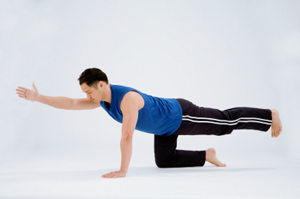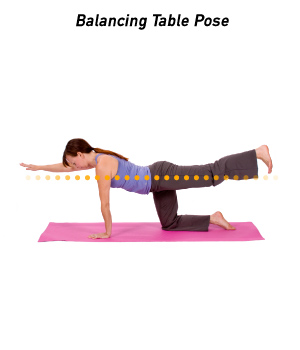How to Do Balancing Table Pose in Yoga
 Balancing Table Pose is a beginning yoga exercise that pairs movement with stretching to help warm and strengthen the body. When you practice Balancing Table Pose, you gently flow between poses that help to balance each side of your body.
Balancing Table Pose is a beginning yoga exercise that pairs movement with stretching to help warm and strengthen the body. When you practice Balancing Table Pose, you gently flow between poses that help to balance each side of your body.
Benefits of Balancing Table Pose
Mastery of yoga is really measured by how it influences our day-to-day living, how it enhances our relationships, how it promotes clarity and peace of mind.
Balancing Table Pose builds abdominal and lower back strength. It warms the body and brings flexibility to the spine, shoulders, and hips, while gently stretching the torso. Because of the balancing challenge, this pose also helps to improve focus, coordination, and overall physical equilibrium. When you coordinate your movement with your breath, the pose also helps to relieve stress, fatigue, and tension.
Cautions
Do not practice this pose if you have a recent or chronic injury to the knees, back, arms, wrists, or shoulders. Always work within your own range of limits and abilities. If you have any medical concerns, talk with your doctor before practicing yoga.
Instructions

- Begin on your hands and knees, with your hands directly under your shoulders and your knees directly under your hips (this is called Table Pose). Un-tuck your toes so the tops of your feet are pressing against the floor. The fold of your wrists should be parallel to the top edge of your mat.
- Gaze at a point between both of your palms.
- Draw your belly button toward your spine without arching your back. Then, extend your right leg behind you. Tuck your toes and keep them resting on the mat. Press back through the ball of your foot to lengthen your leg. Keep your spine neutral.
- With your abdominal muscles engaged, extend your left arm forward to shoulder-height, and reach through your fingertips. At the same time, lift your leg off the floor, a few inches or all the way to hip-level. Do not lift your leg higher than shoulder-level.
- Hold for a count of three.
- Exhale and release back to Table Pose, on both hands and knees.
- Repeat on the other side, extending your left leg and right arm. Hold for the same amount of time, then release back to Table Pose. This is one round.
- Complete 5-10 rounds, then rest in Child's Pose.
Modifications & Variations
Balancing Table Pose is a great core-strengthening yoga move for beginners. There should be very little discomfort and no pain when practiced. To find a variation of the pose that works for you, try one of these modifications:
- If your knee caps hurt, fold your mat or place a firm blanket under your knees.
- For a deeper stretch to your shoulders and hips — and a greater balance challenge — reach your extended arm and leg out to the side instead of forward and back.
- To add variety to your balance challenge, lift your right arm and right leg, while making sure not to lean your body toward the left. Keep your abdominals engaged and your spine neutral (flat). Repeat with the left arm and left leg.
Tips
Practicing Balancing Table Pose can help to warm your body and prepare it for a deeper yoga practice. Keep the following information in mind when practicing this sequence:
- Keep your spine in a neutral position throughout the repetitions: Do not let your belly drop, as this can over-arch your lower back and cause injury.
- Keep your gaze at a spot between your palms: Looking forward can crunch your neck, causing tension, pain, and possible injury.
- Your shoulder blades should be broad: Your shoulders should be drawn away from your ears. Keep your collar bones broad, as well. This helps to protect your neck, while also increasing flexibility and strength in your shoulders and chest.
- Be aware of your breath and its coordination with your movements: Breathe smoothly and evenly throughout the practice.
Balance Your Body
Practicing coordinated movement, such as Balancing Table Pose, helps your body become more balanced. Try a few rounds of this pose before moving deeper into your practice, or as a standalone exercise to help build core and shoulder strength. It can be a great way to stretch out stiff muscles after sitting for a long period, too! Regular practice of this pose will help you build grace and poise in all areas of your life.

